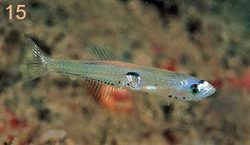Bathygobius burtoni is a species of goby native to the Atlantic shores of western Africa where it is a denizen of tide pools. This species can reach a total length of 8 cm (3.1 in). The specific name honours Captain Sir Richard Francis Burton (1821-1890), the English explorer, geographer, translator, writer, soldier, orientalist, cartographer, ethnologist, spy, linguist, poet, fencer, and diplomat, who collected the type specimen. This species has a very limited distribution and is known from only five locations in an area in which there has been a huge increase in the human population and the IUCN has assessed this species an Endangered.

The rock goby is a small coastal goby of eastern Atlantic waters, from Scotland to Senegal. It is also reported from the Mediterranean and Black Seas, and is an anti-Lessepsian migrant in the Gulf of Eilat and Red Sea. There are unconfirmed records from the area around Pointe Noire in Congo-Brazzaville.
Risor ruber, the Tusked goby, is a species of goby native to reefs of the western Atlantic Ocean from southern Florida to the Bahamas and south to northern Brazil. This species associates with barrel sponges, sometimes living within the sponge. This species can reach a length of 2.5 centimetres (0.98 in) TL. It is currently the only known member of its genus.

Coryphopterus glaucofraenum, the bridled goby, is a species of goby native to the Western Atlantic Ocean and the Caribbean Sea from North Carolina to Brazil. It can be found on reefs at depths of from 2 to 45 metres in areas of white sand. This species can reach a length of 8 centimetres (3.1 in) TL. It occasionally makes its way into the aquarium trade.

Rhinogobiops is a genus of true gobies in the family Gobiidae. It is monotypic, being represented by the single species, Rhinogobiops nicholsii, also known as the blackeye goby, bluespot goby, and crested goby. They are common inhabitants of coral reefs and rocky habitats along the eastern Pacific Ocean coasts of Mexico, the United States, and Canada, although they are hardly noticed, as they often rest motionless near their shelters.
Elacatinus horsti, the yellowline goby, is a species of goby native to the western Atlantic Ocean and the Caribbean Sea.
Elacatinus chancei, the shortstripe goby, is a species of ray-finned fish in the family Gobiidae. It lives inside or on the surface of a sponge and occurs in tropical waters in the west central Atlantic Ocean, the Bahamas, the Antilles, and Venezuela.
Coryphopterus is a genus of gobies primarily found in the western Atlantic Ocean, although some species are found in the Indian and/or Pacific oceans.

Crystallogobius linearis, the crystal goby, is a species of goby native to the Atlantic coasts of Europe and the Mediterranean Sea where it can be found at depths of from 1 to 400 metres. Males of this species grow to a length of 4.7 centimetres (1.9 in) SL while females only reach 3.9 centimetres (1.5 in) SL. This species is the only known member of its genus. The name Crystallogobius comes from the Latin words cristallum, meaning "crystal", and gobius, meaning gudgeon.
Ginsburgellus novemlineatus, the Nineline goby, is a species of goby native to tropical reefs of the western Atlantic Ocean and the Caribbean Sea. It is frequently found associated with the sea urchin Echinometra lucunter, living underneath the urchin. This species grows to a length of 2.5 centimetres (0.98 in) TL. This species can also be found in the aquarium trade. This species is the only known member of its genus, the name of which honours the ichthyologist Isaac Ginsburg (1886-1975) of the U.S. National Museum who had an interest in gobies.
Coryphopterus thrix, the bartail goby, is a species of goby found in the western Atlantic Ocean from southern Florida and the Bahamas to Brazil.
Coryphopterus alloides, the barfin goby, is a species of goby found in the western Atlantic Ocean from southern Florida and the Bahamas to Belize.

Coryphopterus dicrus, the Colon goby, is a species of goby found in the western Atlantic Ocean from southern Florida and the Bahamas to Brazil.

Coryphopterus eidolon, the pallid goby, is a species of goby found in the western Atlantic Ocean from southern Florida and the Bahamas to Brazil.

Coryphopterus hyalinus, the glass goby, is a species of goby found in the western Atlantic Ocean from Florida and the Bahamas to Central America and the Lesser Antilles.

Coryphopterus lipernes, the peppermint goby, is a species of goby found in the western Atlantic Ocean from Florida and the Bahamas to Central America and the Lesser Antilles.

Coryphopterus venezuelae is a species of goby found in the western Atlantic Ocean from Belize to Panama, the north coast of South America, Curaçao, Venezuela. It is also found in the Bahamas, the U.S. Virgin Islands, Puerto Rico, Saba, and Brazil.

Coryphopterus punctipectophorus, the spotted goby, is a species of goby found in the western Atlantic Ocean.

Coryphopterus tortugae, the patch-reef goby, is a species of goby found in the western-central Atlantic Ocean.

Coryphopterus personatus, the masked goby, is a species of goby found in the western-central Atlantic Ocean.













